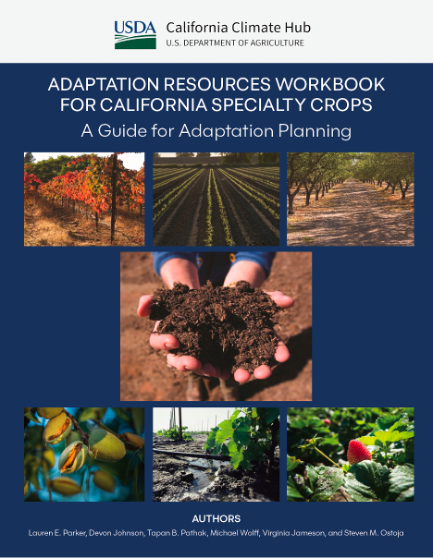In recent decades, California’s climate has seen warmer temperatures and earlier snowmelt, and climate change is projected to bring more frequent and intense droughts and heatwaves to the state punctuated by extreme precipitation and flooding. As the state faces the effects of a changing climate, agricultural production will be challenged and its specialty crop industry may be uniquely vulnerable. For example, warming winter temperatures will reduce the accumulation of winter chill that is needed for fruit and nut crops, warmer springs may advance bloom in crops like almonds, and warmer summers may mean earlier harvest for tomatoes. Warmer temperatures can also influence the timing and intensity of pest pressure, while extreme heat events place additional stress on crops and the water resources that farmers rely on to manage the heat.
To help producers cope with these and other effects of climate change, the USDA California Climate Hub created the Adaptation Resources Workbook for California Specialty Crops. The details within the workbook provide science-based information for developing a farm management plan that explicitly incorporates climate adaptation. Producers can follow the five-step process offered by the workbook and developed by the Northern Institute for Applied Climate Science (NIACS) for assessing the risks and vulnerabilities of land management goals to climate change.

Throughout the workbook, resources ⏤ such as Cooperative Extension guides, NRCS technical documents, and scientific literature ⏤ and guidance are provided. Central to the five-step process is the adaptation menu, which offers a non-exhaustive list of science-based, climate-adaptive actions that producers can use as a starting point for identifying adaptation practices for their operations.

The adaptation menu organizes adaptation actions by high-level strategies including supporting soil health, dealing with variable water availability, managing for pests and weeds, coping with extreme events, and landscape-scale farm management. In addition, the menu includes one strategy that is entirely focused on mitigation actions that either reduce on-farm greenhouse gas emissions or increase carbon sequestration.
Each strategy within the menu is organized by adaptation approaches, which provide guidance and more specificity on how a particular strategy might be implemented and more detail on the importance of the approach for agricultural adaptation. Within the text of the workbook, each approach offers several on-the-ground practices that can be adopted to achieve the identified adaptation goals.
While the workbook and menu do not provide all of the information and resources producers might need to develop a climate-informed farm management plan, by using this workbook in conjunction with the resources, information, and expertise offered by technical service providers California's specialty crop producers can improve their farms' resiliency, adaptive capacity, and mitigation potential.


